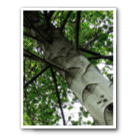|
Jeremy usually uses young, 20-30 year old, Welsh sycamore
trees cut green with traditional swivel knives (see video below)
out of a split trunk. This allows the wood to be cut following the
grain and minimises the risk of tension within the wood causing
splits and uneven shrinkage.
He hand dyes the leather for each pair which has so much oil
within its structure that it inevitably influences the final
colour which can be a little unpredictable. Hides vary in their
oil content and there are even variations within each hide.
|
|
Jeremy makes alder clogs (above) on request. It is
a softer less durable wood than sycamore but it was the wood of choice
throughout the industrial revolution. Alder eventually molds to
the shape of the foot. In past times it was said that the mill
girls would save the soles of old pairs of alder clogs because
they had crushed to the shape of their feet and were really
comfortable when standing at the looms all day. They'd ask the
clog maker to unpick the tops and carefully put a new one on.
 |
Alder is very resistant to decay under water and was used for
water pipes, pumps, troughs, small boats and piles under bridges
and houses. |
Jeremy has travelled in Spain and France
researching European clog making traditions. He demonstrates his
skill at
County and Craft Fairs across Britain during the summer.
|
|
As the last person in England following a centuries old craft
he has written about the tradition of clog making. He discusses
the various designs of these unique shoes and their place in
society.
|
|